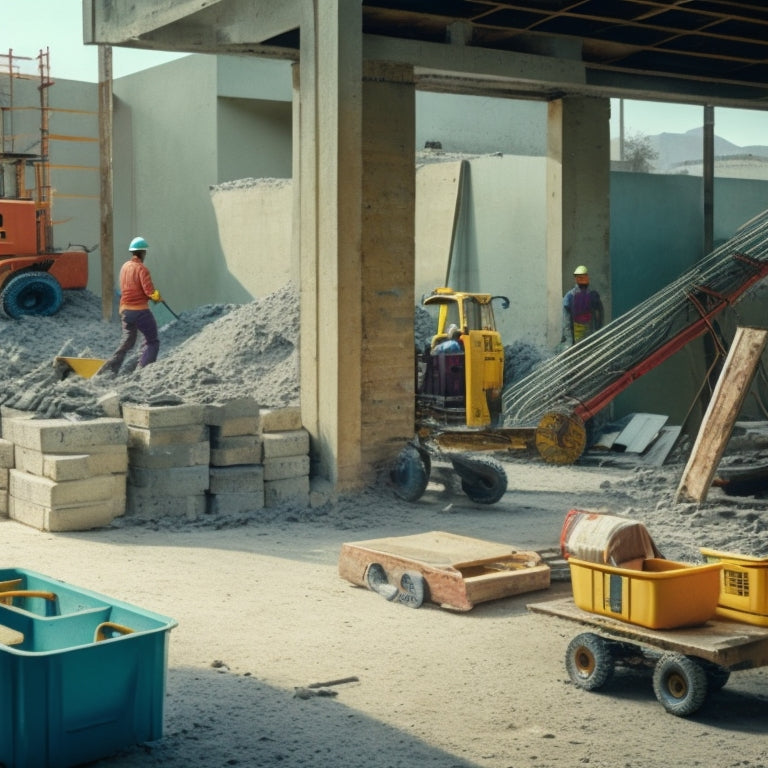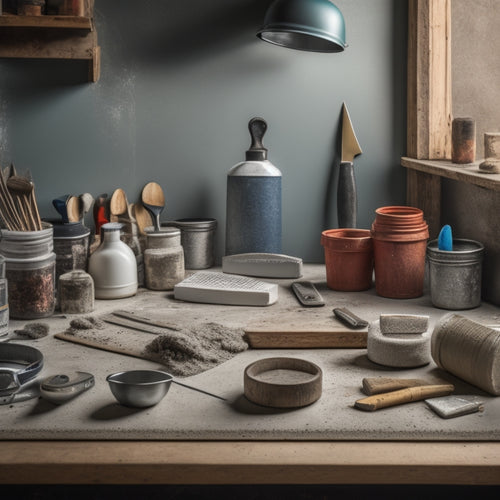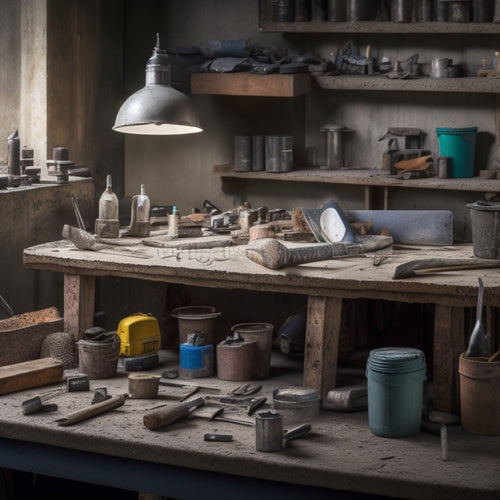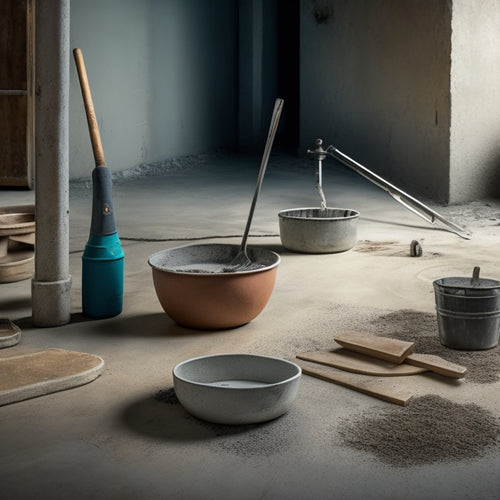
What Tools Do You Need for Concrete Block Construction
Share
You'll need a thorough set of specialized tools to guarantee a successful concrete block construction project. Essential masonry tools include trowels, leveling tools, and joint finishing tools. Safety gear like hard hats, safety glasses, and dust masks are also a must. Block laying and alignment tools, such as alignment pins and measuring tapes, help guarantee accurate placement. Concrete mixing equipment, block cutting and shaping tools, and mortar preparation tools are also necessary. Additionally, you'll need cleaning and finishing tools to achieve a professional look. As you begin planning your project, you'll want to familiarize yourself with each of these tools and their applications.
Key Takeaways
• Essential masonry tools include trowels, leveling tools, joint finishing tools, and safety gear for concrete block construction.
• Block laying and alignment tools, such as alignment tools and measuring tools, ensure accurate block placement and spacing.
• Concrete mixing equipment, including mixers and maintenance, is necessary for preparing mortar and concrete for blocks.
• Block cutting and shaping tools, like masonry saws and grinding wheels, are used to customize block sizes and shapes.
• Mortar preparation tools, cleaning tools, and finishing tools are necessary for preparing and finishing concrete block surfaces.
Essential Masonry Tools
You'll need a set of reliable essential masonry tools to guarantee a solid foundation and a structurally sound concrete block construction project. Don't even think about attempting to wing it with subpar tools – it's a recipe for disaster! Investing in quality tools will save you time, money, and a whole lot of frustration in the long run.
First and foremost, you'll need a sturdy trowel for applying and smoothing out mortar. A level and a string line will make certain your blocks are aligned and plumb. A jointer or joint raker will help you finish the joints, while a pointing trowel is perfect for applying and finishing pointing mortar. Don't forget a hammer, safety glasses, and a dust mask to protect yourself from debris and dust.
To master masonry techniques, it's essential to maintain your tools in top condition. Regular tool maintenance is key to extending the life of your tools and preventing accidents. Keep your tools clean, dry, and well-oiled to make sure they're always ready for action.
With the right tools and a bit of know-how, you'll be well on your way to building a concrete block construction project that's both durable and impressive.
Block Laying Patterns Tools
Accurate block laying patterns require specialized tools, including a block laying pattern gauge, a spirit level, and a chalk line reel, which enable you to achieve precise course alignment and joint spacing.
These tools will be your new best friends as you master various block laying techniques and explore different block pattern variations.
To guarantee your blocks are laid out correctly, you'll need:
-
Block laying pattern gauge: This tool helps you maintain consistent spacing and alignment between blocks.
-
Spirit level: A must-have for making sure your blocks are perfectly level and plumb.
-
Chalk line reel: This handy tool allows you to snap a chalk line to guide your block laying, ensuring straight courses and accurate joint spacing.
- Block alignment pins: These pins help you maintain accurate block alignment and prevent deviations from your desired pattern.
With these tools in your arsenal, you'll be well on your way to creating stunning concrete block structures that are both functional and visually appealing.
Concrete Mixing Equipment
With your blocks laid out perfectly, it's time to focus on preparing the concrete that will hold them together, and that requires the right concrete mixing equipment. You'll need a mixer that can handle the volume of concrete you need, as well as the type of mix you're using. Don't skimp on quality – a good mixer will make all the difference in the strength and durability of your concrete.
Here are some key considerations for your concrete mixing equipment:
| Equipment | Capacity | Mixing Techniques |
|---|---|---|
| Hand mixer | Small batches | Slow, gentle mixing |
| Portable mixer | Medium batches | Fast, aggressive mixing |
| Stationary mixer | Large batches | Continuous, consistent mixing |
| Concrete pump | Large volumes | High-pressure, fast mixing |
Remember to always follow proper equipment maintenance to guarantee your mixer is running smoothly and efficiently. Regular cleaning, lubrication, and inspections will help prevent breakdowns and extend the life of your equipment. Don't forget to also follow proper mixing techniques to guarantee your concrete is strong and consistent. With the right equipment and techniques, you'll be well on your way to a solid foundation for your concrete block construction project.
Block Cutting and Shaping
When you're working with concrete blocks, you'll often need to customize their profiles and edges to fit specific design requirements.
You'll use specialized cutting tools to trim blocks to precise dimensions, ensuring a snug fit and minimizing waste.
Cutting Block Profiles
You'll need to select the appropriate cutting tool to achieve the desired profile for your concrete blocks, ensuring a precise fit and minimizing waste.
Cutting block profiles requires mastering various block profile techniques to optimize cutting efficiency. To get started, consider the following essential tools:
-
Masonry saw: A powerful saw designed for cutting through concrete blocks, ideal for straight cuts and precise angles.
-
Block chisel: A handy tool for removing small sections of block material, perfect for creating curved or irregular profiles.
-
Diamond blade saw: A high-speed saw equipped with a diamond-coated blade, capable of making precise, curved cuts with ease.
- Grinding wheel: A versatile tool for smoothing out rough edges and refining block profiles to perfection.
Shaping Block Edges
Now that you've mastered cutting block profiles, it's time to focus on refining the edges of your concrete blocks to achieve a professional finish. This is where block edge finishing comes into play.
You'll need to employ edge shaping techniques to guarantee your blocks fit together seamlessly. For a smooth, rounded edge, use a block edger or a concrete edging tool. These tools will help you remove any rough spots and create a uniform edge.
If you're looking for a more decorative edge, consider using a block profiler or a concrete profiler. These tools will allow you to create unique edge designs, such as a bullnose or a chamfered edge.
Remember, the key to achieving a professional finish is attention to detail. Take your time when shaping the edges of your blocks, and don't be afraid to experiment with different edge shaping techniques.
With practice, you'll be a pro at block edge finishing in no time!
Mortar Preparation Tools
Set up your mixing area with the essential mortar preparation tools, including a mixing bucket, trowel, and level, to guarantee a strong and consistent bond between concrete blocks. You're about to get your hands dirty, so make certain you have the right gear!
Here are the must-haves for mortar preparation:
-
Mixing bucket: A sturdy, clean bucket to mix your mortar. Don't skip this – you don't want your mortar to be contaminated with debris!
-
Trowel: A trusty trowel for scooping, spreading, and finishing mortar. You'll be using this guy a lot!
-
Level: Ascertain your blocks are aligned perfectly with a reliable level. No wonky walls here!
- Mortar mixing stick or paddle: A sturdy stick or paddle to mix your mortar. Get in there and get mixing!
With these tools, you'll be well on your way to achieving a strong bond between your concrete blocks.
Leveling and Alignment Tools
Accurate leveling and alignment of concrete blocks are critical to the structural integrity of your build, and the right tools guarantee a precision layout that prevents costly mistakes and rework. You don't want to be that guy who has to tear down a whole wall because it was off by a fraction of an inch. Trust us, it's not fun.
To verify your blocks are perfectly aligned, you'll need the following tools:
| Tool | Purpose | Why You Need It |
|---|---|---|
| Laser Levels | Projects a level line or dot onto the surface | Confirms accurate horizontal and vertical alignment |
| Alignment Rods | Extends from the laser level to the block | Provides a precise reference point for block placement |
| Leveling Stakes | Temporarily secures blocks in place | Allows for precise adjustments before final placement |
| String Lines | Creates a straight reference line | Helps maintain alignment over long distances |
These tools work together to give you a precise and accurate layout. Don't skimp on these essentials – your build (and your sanity) depend on it. With the right tools, you'll be building like a pro in no time!
Safety Gear and Accessories
As you prepare to tackle your concrete block construction project, don't forget to gear up with the necessary safety equipment and accessories to protect yourself from potential hazards. You don't want to end up as a human-sized concrete block, do you?
Here are some essential safety gear and accessories you'll need:
-
Hard hat: A must-have to protect your noggin from falling objects and debris.
-
Safety glasses: Because concrete dust and flying particles are no joke when it comes to your peepers.
-
Steel-toed boots: Your toes will thank you when you avoid a 50-pound concrete block 'accident'.
- Gloves: Protective clothing that'll keep your hands safe from cuts, abrasions, and concrete's alkalinity.
Measuring and Marking Tools
You'll need to take precise measurements and mark your concrete blocks correctly to guarantee a strong and durable structure, which is where your measuring and marking tools come into play.
A good tape measure is essential for taking accurate measurements. Look for one that's sturdy, easy to read, and has a long enough blade to reach across your blocks.
You'll also need a reliable chalk line to snap straight lines across your blocks. This tool is a game-changer when it comes to marking cuts, layouts, and patterns. Don't skimp on quality here – a good chalk line will save you time and frustration in the long run.
When marking your blocks, make sure to use a level to verify your lines are straight and level. You don't want your structure to end up wonky because of sloppy measurements!
With these tools in your arsenal, you'll be able to measure and mark your blocks like a pro, setting yourself up for a successful concrete block construction project.
Cleaning and Finishing Tools
When you're working with concrete blocks, you'll need to clean and finish them properly to achieve a professional-looking result.
You'll use specialized cleaning tools to remove debris and dust from the block's surface, preparing it for finishing coats.
Next, you'll apply these coats using specific finishing tools, ensuring a smooth, even finish that meets your project's requirements.
Removing Debris and Dust
What tools do you need to guarantee a clean and dust-free surface for finishing and applying subsequent coatings or treatments to your concrete block construction project? You're about to find out!
Removing debris and dust is a vital step in preparing your concrete blocks for the final touches. After all, you don't want any unwanted particles ruining your masterpiece.
Here are the essential tools you'll need for debris removal and dust control:
-
Brooms and dustpans: For sweeping away loose debris and dust from the surface.
-
Vacuum cleaners: Equipped with HEPA filters to capture even the finest dust particles.
-
Damp cloths or mops: To wipe down surfaces and prevent dust from becoming airborne.
- Dust-control sprays: To suppress dust and prevent it from spreading during cleaning.
With these tools, you'll be able to achieve a spotless surface, free from debris and dust. This is fundamental for ensuring a strong bond between the concrete blocks and any subsequent coatings or treatments.
Applying Finishing Coats
Now that your concrete block surface is clean and dust-free, turn your attention to applying finishing coats, which demands a distinct set of tools to achieve a smooth, even, and professional-looking result.
You'll need a variety of tools to master different finishing techniques, from simple to complex texture application.
First, grab a high-quality trowel to apply and smooth out your chosen finish. A putty knife or edger will help you get into tight spaces and corners.
If you're going for a textured look, you'll need a texture sprayer or a stamper to add some personality to your wall. A finishing broom or tamping tool will help you achieve a uniform finish.
Don't forget a level and a straightedge to guarantee your coats are applied evenly.
Frequently Asked Questions
Can I Use a Regular Drill for Mixing Concrete?
Don't even think about using a regular drill for mixing concrete!
You'll end up with a burnt-out motor and a mess on your hands.
For concrete mixing, you need a heavy-duty drill with a paddle mixer attachment or a dedicated concrete mixer.
These drill types are designed to handle the thick, heavy mixture, ensuring a smooth, consistent mix.
Trust us, your regular drill (and your sanity) will thank you for the upgrade!
How Long Does It Take to Learn Block Laying Skills?
Can you really master block laying overnight? Probably not. It takes time and practice to develop the skills.
The good news is that you can acquire block laying techniques quickly, typically within a few weeks to a few months, depending on how often you practice.
Focus on mastering the basics, and you'll be laying blocks like a pro in no time.
Just remember, patience is key in any skill acquisition timeline.
Are Concrete Blocks Suitable for Building a Load-Bearing Wall?
You're wondering if concrete blocks are up to the task of building a load-bearing wall? Absolutely!
When laid correctly, concrete blocks provide excellent load-bearing capacity and wall stability. You'll need to guarantee proper foundation prep, consistent mortar application, and precise block alignment.
But with attention to detail, you can trust your wall to hold its own. Just remember, it's all about the foundation – get that right, and your wall will be rock-solid (pun intended)!
Can I Use a Hammer Drill for Drilling Into Concrete Blocks?
You're about to begin a concrete block adventure, and you're wondering if your trusty hammer drill is up for the task.
Think of your hammer drill as a superhero, and concrete blocks as the kryptonite. Not all hammer drills are created equal, though.
You'll need a rotary hammer drill or a SDS-max drill for concrete block applications. These types of drills are specifically designed to tackle tough concrete, so you can save the day (and your wall) from crumbling under the pressure.
Do I Need a License to Build a Concrete Block Structure?
Before you start building your concrete block masterpiece, you're wise to wonder if you need a license.
The answer depends on your location and the structure's purpose. Check your local building regulations and licensing requirements - they can vary wildly.
Don't get caught without the proper paperwork, or you'll be forced to tear it down. Research thoroughly, and you'll avoid costly mistakes.
Conclusion
You've finally gathered all the necessary tools for concrete block construction. Congratulations, you're now the proud owner of a garage that resembles a war zone, with tools scattered everywhere like landmines.
Your neighbors will be green with envy as they gaze upon your impressive collection of trowels, levels, and mixers.
But don't get too comfortable; you still have to actually build something with them.
Good luck, and may the odds be ever in your favor!
Related Posts
-

Essential Tools for Concrete Wall Covering Projects
When tackling a concrete wall covering project, you'll need a range of essential tools and equipment. For cleaning an...
-

Top Tools for Concrete Repair Success
When it comes to concrete repair success, you'll need a well-stocked toolkit with essential hand tools like trowels, ...
-

Why You Need These Concrete Overlay Tools
When tackling a concrete overlay project, you need the right tools to achieve a flawless finish and avoid costly mist...


